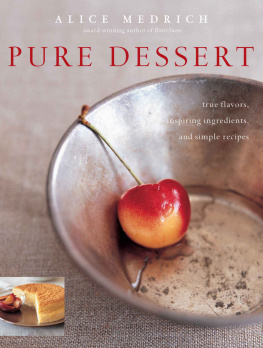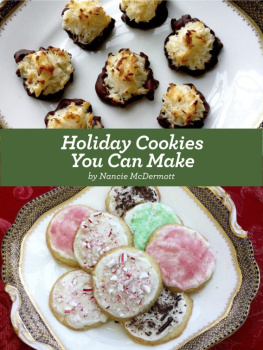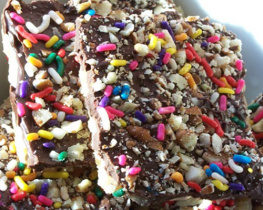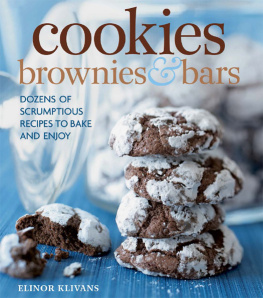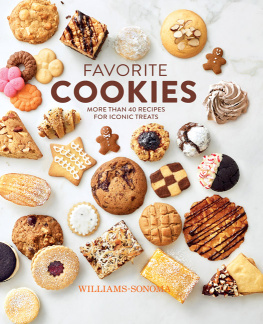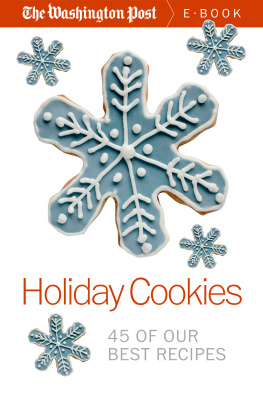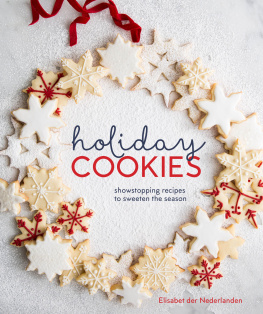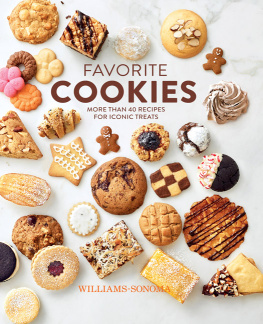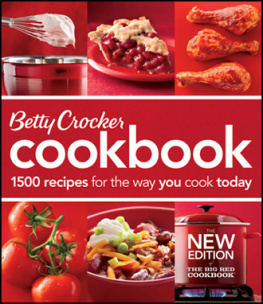

THE
ARTISANAL
KITCHEN
Holiday
Cookies
The Ultimate Chewy, Gooey, Crispy, Crunchy Treats
Alice Medrich

Artisan | New York
Also in This Series
The Artisanal Kitchen: Perfect Pasta
The Artisanal Kitchen: Perfect Pizza at Home
The Artisanal Kitchen: Vegetables the Italian Way
The Artisanal Kitchen: Holiday Cocktails
The Artisanal Kitchen: Party Food

Contents

Introduction
C ookies are easy, enticing, and fun. They invite creativity and reward experimentationno rocket science required. An array of cookies is inherently festivenothing says holiday better! Whether youre creating a dessert spread for Thanksgiving, toting a hostess gift to a dinner party, or joining a cookie swap, homemade cookies are always in style.
These holiday cookies were handpicked from my repertoireincluding familiar favorites and my own inventionshoned over the years to reflect todays spirit of adventure and culinary sensibilities. I selected them by asking myself, Do I still love these? Do they appeal to our tastes today? Some have more spice than our moms and grandmas used, or new spices. Some have different leavenings, baking temperatures, or pan linersto improve texturesthan you might be used to. Some have a tad less sugar or butter or more salt to heighten flavors. Some include ingredients that we now adore but which were once considered too exotic or hard to get.
In an era when most people cling to the recipe on the bag of chocolate chips (or buy rather than bake cookies), you will find these recipes updated but still friendly, outrageously good, and even hip (but not too hip!). In the bargain, youll get my best tips and tricks for making the best cookies of your life.
Youll love the perfect simplicity of crunchy-but-tender butter cookiesnothing more than butter, flour, sugar, vanilla, and saltand festive variations like Eggnog Cookies and Bourbon Pecan Butter Cookies. Let the fragrance of warm spices and molasses fill your home with holiday spirit; dont miss My Ginger Cookies (made in one bowl and with loads of ginger!) and pretty jam-filled Linzer Cookies. Invited to a cookie swap? A gooey bar or a dramatic cookieRoberts Brownies My Way, Caramel Cheesecake Bars, Very Tangy Lemon Bars, or Bittersweet Decadence Cookieswill steal the show and burnish your reputation as the best cookie baker ever! Happy holidays to all.
Users Guide
No matter what kind of cookie you choose, you will get the most from this book if you read the information in this chapter before you start with any of the recipes.
Cookie recipes are the simplest in the bakers repertoire: ingredient lists are brief and familiar, and instructions are few and uncomplicated. But simplicity does not mean a recipe can be executed casually, that the details are whimsical, or that the measurements are flexible. In reality, cookies are tiny pastries. As such, they are subject to all the rules of baking: mundane acts of measuring and mixing, cookie sheet preparation, oven temperature, and timing make the difference between tough and tender cookies and between ordinary and extraordinary cookies. If youve ever eaten ten chocolate chip cookies made by ten different bakers all using the same recipe, you know what I mean.
The information that follows will get you into my kitchen and my head by explaining why I do what I do and why some of my methods may be different from what you are accustomed to or what you find in other books.
Decoding Recipe Language
A good recipe uses specific descriptive language to tell you what to do, when and for how long to do it, and with what utensil. It includes visual cues to look for so you know you are on the right track. All of this is designed to help you achieve results that resemble those that we got in my kitchen. If you change the details, you will change the resultsfor better or for worse!
Phrases like just until are important. When the recipe asks you to mix just until the dry ingredients are blended, or warm the chocolate just until it is melted, or bake just until the edges are brown, you know that more mixing, warming, or baking is not better and your cookies could suffer.
The texture of your cookie is also affected by how you mix: terms like stir, fold, beat, and whip are used to guide you. When a recipe calls for mixing, stirring, or folding, you are meant to act gently (but decisively) to incorporate ingredients without destroying or changing the texture of the batter. For beaten egg whites, the goal is to preserve as much of the air in the batter as possibleexcessive or vigorous mixing or the wrong stroke will deflate these batters. For denser, richer batters (like those for chocolate chip cookies or butter cookies), excessive or vigorous mixing may add too much air or activate too much gluten.
When a recipe calls for beating, whipping, or mixing vigorously, you are meant to aerate the mixture and/or make sure that the ingredients are emulsified. This is done with an electric mixer or by hand, depending on the recipe. Egg whites are whipped at medium to high speed with an electric mixer with the whisk attachment. Heavier, richer batters and doughs are mixed with the flat beater or paddle attachment or by hand with a spatula at a brisk pace.
Finally, note that measures given in ounces always refer to weights rather than volume (see for a fuller explanation).
FAQs
Successful baking is all in the details. The simplest things can make the difference between a perfectly tender cookie and a doughy paperweight, between a soggy cookie and one that is sublimely crisp. Each recipe spells out the important details for that cookie, but here is the background.
What makes cookies tough?
Tough cookies often result from badly measured flour, the wrong kind of flour (bread flour or whole-grain flours rather than all-purpose flour), too much mixing after the flour has been added to the moist ingredients in the batter, or too much flour used to keep the dough from sticking to the rolling pin or the countertop. Other culprits include too much kneading and rerolling of scraps and baking at too high or too low a temperature or for too long.
The fix? Use the flour called for in the recipe, measure it accurately, mix it just enough (as called for in the recipe), avoid excessive rerolling, roll out between sheets of wax paper or plastic wrap, and check your oven and timer. You may also increase tenderness with a finer granulation of sugar, either by using superfine sugar or by grinding regular sugar to a finer consistency in a food processor.
How important is careful measuring?
A creative approach to measuring does not always spoil cookies. You may use a liberal hand with raisins, nuts, chocolate chips, coconut, or even vanilla. Feel free to substitute dried fruits and nuts one for another and to experiment with extracts and flavors.
But for cookies with great textures, and to avoid dry, tough, and leaden cookies, you must carefully measure the baking soda, baking powder, salt, and, most of all, flour. I cannot emphasize enough how many cookie problems can be prevented by knowing how to measure flour correctly.
Next page

